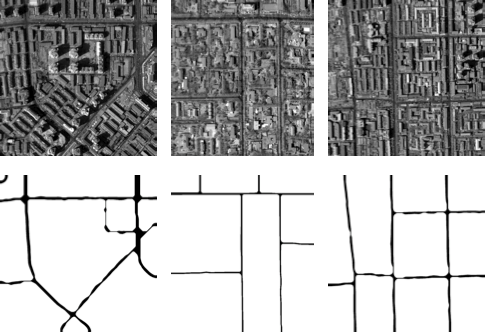|
Abstract
This research is concerned with the segmentation of shapes having the form of a 'network'. A 'network' is composed of branches joining together at junctions, e.g. road, river, vessel, etc. Specifically, our goal is to model the prior geometry of network regions at different scales of the image. The application is to detect road networks R from very high resolution (VHR) QuickBird images (~0.61 m/pixel) in dense urban areas.
To model families of regions such as network, Rochery et al. [1] introduced `higher-order active contours' (HOACs). HOACs incorporate not only local, differential knowledge about the boundary, but also nonlocal, long-range interactions between tuples of contour points. Building on this work, the model energy E(R) is defined as the sum of two pieces: a HOAC prior energy EP(R) describing the geometric prior knowledge of the network regions, that is, elongated structures with parallel borders and slowly varying width that meet at junctions; and a data energy ED(I, R) describing the image I we expect to see given a road network R. By minimizing the total energy E with respect to R, an estimate of the road network is obtained.
The complete task is tackled in two steps. First, we choose to work on extracting the main road networks. This is still not a trivial problem. The images are complicated, with much 'noise' in the road region due to cars, road markings, etc., while the background is very varied, containing many features that are locally similar to roads. To cope with these difficulties existing in the VHR images, we propose two terms:
- Multi-scale data term, to combine information from multiple scales.
- Specific prior term, to introduce stronger prior knowledge.
Subsequently, we turn to the issue of extracting the secondary road networks. These are much more difficult because their radiometric properties are very similar to those of the background, and because secondary roads are often obscured by shadows and trees. Furthermore, the generic prior term in [1] suffers from a severe limitation: network branch width was constrained to be similar to maximum network branch radius of curvature, thereby it provides a poor model of networks with straight narrow branches. A straightforward solution is to separate the interactions between pixels on the same and opposite sides of a network branch. To achieve this goal, we propose two new types of HOAC term:
- Nonlinear nonlocal prior term, to enlarge the magnitude of the interaction along one side of a network branch.
- Linear nonlocal prior term, to increase the range of the interaction along one side of a network branch.
Related publications
- T. Peng, I . H. Jermyn, V. Prinet, J . Zerubia. Extended Phase Field Higher-Order Active Contour Models for Networks: Its Application to Road Network Extraction from VHR Images , International Journal of Computer Vision (IJCV), 88(1), pp. 111-128, 2010
- T. Peng, I. H. Jermyn, V. Prinet, J . Zerubia. A robust framework based on phase field modeling for road network extraction from VHR satellite images, Chinese Journal of Computers (in Chinese), 2009
-
T. Peng, I. H. Jermyn, V. Prinet, and J. Zerubia. An extended phase field higher-order active contour model for networks and its application to road network extraction from VHR satellite images. In Proc. European Conference on Computer Vision 2008 (ECCV 2008), Marseille, France, October 13-16, 2008. (poster)
-
T. Peng, I. H. Jermyn, V. Prinet, and J. Zerubia. Incorporating generic and specific prior knowledge in a multi-scale phase field model for road extraction from VHR images. IEEE Trans. Geoscience and Remote Sensing Special Issue: Selected Topics in Applied Earth Observations and Remote Sensing , 1(2):139-146, 2008.
-
T. Peng, I. H. Jermyn, V. Prinet, and J. Zerubia. Extraction of main and secondary roads in VHR images using a higher-order phase field model. In Proc. XXI ISPRS Congress, Commission III, Beijing, China, July 3-11, 2008. (slides, videos)
-
T. Peng, I. H. Jermyn, V. Prinet, J. Zerubia, and B. Hu. A phase field model incorporating generic and specific prior knowledge applied to road network extraction from VHR satellite images. In Proc. British Machine Vision Conference 2007 (BMVC 2007), Warwick, UK, September 10-13, 2007. (poster)
-
T. Peng, I. H. Jermyn, V. Prinet, J. Zerubia, and B. Hu. Urban road extraction from VHR images using a multiscale approach and a phase field model of network geometry. In Proc. 4th IEEE GRSS/ISPRS Joint Workshop on Remote Sensing and Data Fusion over Urban Areas (URBAN 2007), Paris, France, April 11-13, 2007.
[1] M. Rochery, I. H. Jermyn, and J. Zerubia, ``Higher-order active contours'', Int J. Comput. Vis., vol.69, no.1, 2006.
|
|
|
